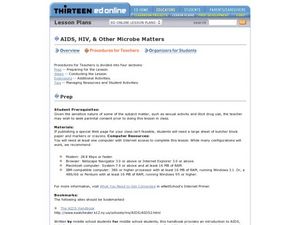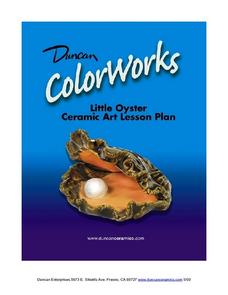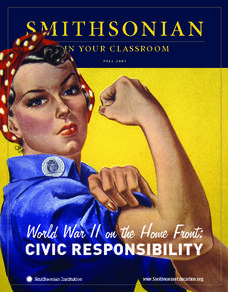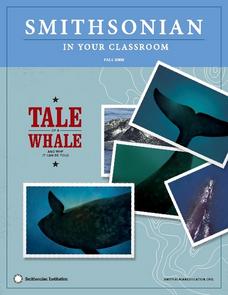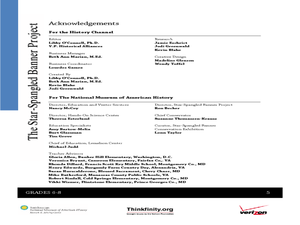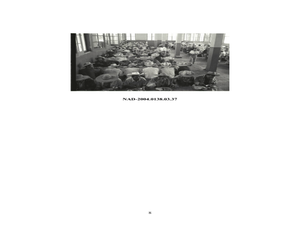Curated OER
Artwork of World Cultures
Seventh graders research a culture and art produced by the people of that culture. They create a PowerPoint presentation to explain their findings. Students make a sand painting depicting the art of that era.
Curated OER
What would Monet do with a digital Camera?
Students take ditigal pictures of any subject. Using Photoshop Elements, students organize and save their pictures. They edit the pictures using a Paint Dabs filter. Students discuss their photographs and how photography influenced the...
Curated OER
To Tell The Truth
Students create a faux ivory napkin ring using art supplies and knowledge gained from in-class discussions and teacher supplied information in this art lesson plan easily adaptable to a Social Studies or Language Arts classroom.
Curated OER
AIDS, HIV and other Microbe Matters
This series of lessons contains sensitive material. Please review to ensure that the content is suitable for your class. It begins by discussing what microbes are. Scholars are then asked to review a few online resources and answer...
Curated OER
Women
A close study of two works of art provides the introduction to this cross-curricular writing assignment. After comparing the clothing, facial expressions, body language, setting, and color in the two 19th century paintings Tissout’s...
Curated OER
A Closer Look
High schoolers observe an ordinary scene and look for elements of design, dynamics, spatial elements, and music. they then create their own everyday dance.
Curated OER
Little Oyster: Ceramic Lesson
Children will love researching and then creating a bottom dwelling mollusk of their own. They watch clips describing the ocean ecosystem and how oysters fit into their environment. Next, they research what oysters eat and how they look....
Curated OER
Teaching with Collections
Students examine collections. In these real-world collections lessons, students examine and describe buttons and shells. Students will then sort, classify, and graph items according to various indicated descriptors.
Curated OER
World War II on the Home Front: Civic Responsibility
Students explore World War II. In this World War II lesson, students discover how volunteerism demonstrates civic responsibility. The lesson uses World War II-era posters to appeal to the learners and help them to understand the...
Curated OER
A Tale of a Whale: And Why It Can Be Told
Young scholars examine the characteristics of particular whales. In this whale characteristics lesson, students discover the methods scientists use to track whales and attempt to match the unique pattern of callosities themselves. A role...
Curated OER
Abraham Lincoln: The Face of War
Students compare life masks and photos of Abraham Lincoln that were made before and at the end of the Civil War. For this "Faces of War" lesson, students analyze images of Lincoln in a historical context and create a timeline of event.
Curated OER
Building Up, Breaking Down
Young scholars investigate how rocks are modified into construction materials. In this building up and breaking down lesson plan, students explore what happens to building materials over time and how people modify natural materials....
Curated OER
Signs of the Times
Students pretend to be 18th century shopkeepers or trades people and create signs representing their shops or trades.
Curated OER
A Basin Filled With Time
Students use fossil leaves and a mathematical formula to study climate change. In this climate change and fossil lesson plan, students determine the differences in temperatures during two different times during the Cenozoic era using...
Curated OER
Destructive Impact of Environment on Artifacts
Middle schoolers recognize that artifacts are destroyed over time. In this environmental factors on artifacts lesson, students experiment and observe through the microscope to find the environmental impact on artifacts. ...
Curated OER
Dinosaurs are for the Birds
Students use the Internet to see photographs of fossils from dinosaurs. They read articles about dinosaurs and birds and what they had in common. They also examine a dinorama site in which they discover why some dinosaurs needed feathers.
Curated OER
How Did the Other Half Live?
Students study the conditions under which immigrants lived. They determine what it means to make it in America. They observe the connection between immigration and unionization and how immigration changed the City of New York. They...
Curated OER
Native American Dolls
Students examine Native American dolls. They discover the connections between the dolls and the Native American culture and customs. They also use maps to locate the position of different tribes.
Curated OER
Who Works for Nonprofits?
Students identify jobs in the nonprofit sector. In this career education lesson, students use the Internet to research nonprofit jobs in their community. Students complete a resume for employment at a nonprofit organization.
Curated OER
Stolen Property or Finders Keepers
Students explore the questionable acquisition of priceless artworks gained as spoils of World War II. They become investigators and reporters looking into the matter of ownership of the world's greatest art.
Curated OER
Guidelines for Teaching the Holocaust
Eighth graders view a presentation about the importance of the Holocaust. In groups, they complete a workshop in which they discover the reasons and actions behind the event. They share their feelings about the material and stereotypes...
Curated OER
Learning from Photos
Students use photographs to study the Bracero Labor Program. In this analyzing photographs lesson, students are broken up into groups and given a photograph of Bracero laborers. They predict the answers to questions about the photo...
Curated OER
Egyptian Tomb Art: Expressions of Religious Beliefs
Ninth graders are introduced to the Prown's technique of describing various objects. As a class, they view pictures of the pyramids in Egypt and discuss how the size and shape of them show their belief in eternal life and religion. ...
Curated OER
Hitler's Fatal Gamble
Young scholars consider the differences between totalitarianism and democracy. In this comparative politics lesson, students will read a handout describing the major components that comprise totalitarianism and democracy, then they...
Other popular searches
- History of Science Museums
- History Museums
- +History +Museums
- Natural History Museums
- Local History Museums
- "History of Science Museums
- Visiting Museums History



